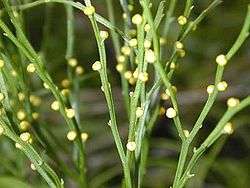Psilotaceae
| Psilotaceae | |
|---|---|
 | |
| Closeup of Psilotum nudum | |
| Scientific classification | |
| Kingdom: | Plantae |
| Division: | Pteridophyta |
| Class: | Psilotopsida |
| Order: | Psilotales Prantl |
| Family: | Psilotaceae J.W. Griff. & Henfr. |
| Genera | |
Psilotaceae is a family of fern-like plants (in order Psilotales) consisting of two genera, Psilotum and Tmesipteris with a dozen species.[1] The two genera are very different and in the past Tmesipteris has been placed in its own family, Tmesipteridaceae,[2] but most classifications continue to place it in Psilotaceae. The relationships of Psilotaceae have been unclear, in part because the plants lack roots or true leaves, but recent molecular systematic studies suggest a relationship to the fern family Ophioglossaceae.[3]
The first genus, Psilotum, consists of small shrubby plants of the dry tropics commonly known as "Whisk ferns". The other genus, Tmesipteris, is an epiphyte found in Australia, New Zealand, and New Caledonia. There has long been controversy about the relationships of the Psilotaceae, with some claiming that they are ferns (Pteridophyta), and others maintaining that they are descendants of the first vascular plants (the Psilophyta of the Devonian period). Recent evidence from DNA demonstrates a much closer relationship to the ferns, and that they are closely related to the Ophioglossales, in particular.
All Psilotaceae share a few characteristics. They are vascular plants and they lack leaves, having instead small outgrowths called enations. The enations are not considered true leaves because there is only a vascular bundle just underneath them, but not inside, as in leaves. Psilotales also do not have true roots. They are anchored by rhizoids. Absorption is aided by symbiotic fungi called mycorrhizae.
Three sporangia are united into a synangium, which is considered to be a very reduced series of branches. There is a thick tapetum to nourish the developing spores, as is typical of eusporangiate plants. The gametophyte looks like a small piece of subterranean stem, but produces antheridia and archegonia.
References
- ↑ Christenhusz, M. J. M. & Byng, J. W. (2016). "The number of known plants species in the world and its annual increase". Phytotaxa. Magnolia Press. 261 (3): 201–217. doi:10.11646/phytotaxa.261.3.1.
- ↑ K. U. Kramer (1990). "Psilotaceae". In K. U. Kramer & P. S. Green (eds.). The Families and Genera of Vascular Plants. I. Berlin: Springer Verlag. p. 22. ISBN 3-540-51794-4.
- ↑ Smith, Alan R.; Kathleen M. Pryer; Eric Schuettpelz; Petra Korall; Harald Schneider; Paul G. Wolf (2006). "A classification for extant ferns" (PDF). Taxon. 55 (3): 705–731. doi:10.2307/25065646. JSTOR 25065646.
External links
| Wikispecies has information related to: Psilotaceae |
| Wikimedia Commons has media related to Psilotaceae. |